Ain’t Nobody Like the Peabody I Got
New Haven (Google Maps location)
September 11, 2010
The Peabody was closed for three years from 2021-2024 for a full refresh. This page will be updated at some point.
Here I am again. Staring at a blank screen and 150 photos of a huge and wonderful museum wondering how in the heck I should approach this monster.
Writing about the giants is by far the hardest thing I do for this website. Connecticut only has a few “monsters” – but I tend to make mountains out of mole hills sometimes so I deal with a few more than you’d think. However, we all agree that the Peabody Museum is a monster no matter who defines it.
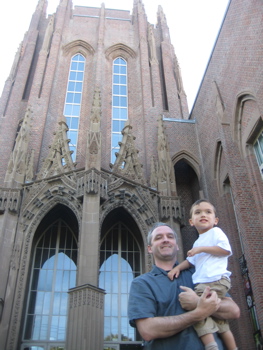
For me especially though, this one is a doozy. I love natural history and natural history museums are my favorite kind of museums. My degree is in ecology and evolutionary biology. I read natural history books for fun. It’s who I am.
And it’s who the Peabody is as well. Fortunately I was joined by my beautiful wife and son for this one, who both offered their pretty faces up for a bunch of my pictures. Having them with me not only allows for a better experience for me, it gives me a better excuse to take the hundred and fifty pictures I mentioned.

Any visit to the Peabody begins outside, on the front lawn before even entering. And, if you have an interest in paleontology, dinosaurs, and the history of science, the giant 13-foot-high, 7,350-pound bronze, horned dinosaur offers a great starting point – but maybe not for all the reasons you think.
Most kids probably run up to the sculpture yelling about the triceratops and are probably a bit confused upon reading that it’s actually a torosaurus. Don’t worry, some scientists who study this stuff their entire lives are confused by this as well.
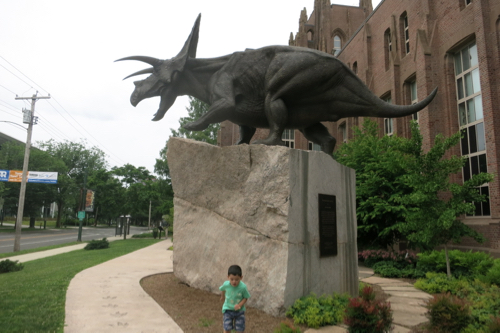
(Some of these pictures are from a later visit after Calvin appeared in the world.)
There have always been debates within the scientific community about taxonomy – even living specie taxonomy. I have always had an affinity for such debates (seriously. No, really) and am fascinated about things like viruses, prions, fungi, ring species, and tanukis. Science likes to figure stuff out, and with the advent of quick, cheaper and more accurate DNA analysis allow biologists to really nail down those “trees of life” you’ve all seen. (And there have been some rather huge taxonomic shifts recently, especially in the plant world).
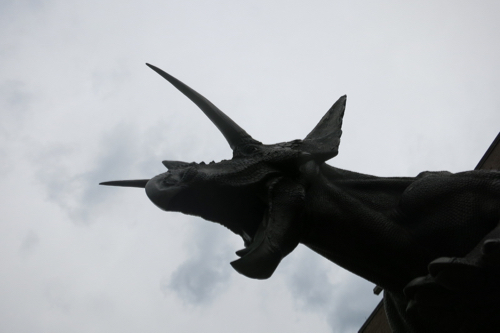
So what am I talking about? Well, there’s actually a debate about whether Mr. Peabody the Dinosaur is a triceratops or a torosaurus. These debates are obviously a bit more difficult due to the extinct nature of the animals in question. But this debate involves one Mr. Jack Horner who is most likely the only present-day paleontologist you’ve ever heard of, if you’ve heard of any at all.
The following is from the Yale Daily News [link dead]:
Montana State University researchers John Scannella and Jack Horner argue that the Torosaurus is not a distinct dinosaur species — in fact, it is just an adult Triceratops, the researchers claimed in a paper published July in the Journal of Vertebrate Paleontology. But Yale paleontologists Nick Longrich and Jacques Gauthier said they have evidence that Yale’s torosauruses are not adults, so they cannot be adult triceratopses.
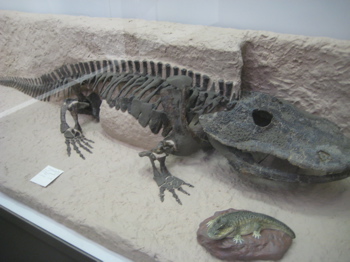
The seemingly trivial matter of a dinosaur’s name crystallizes a broader debate in paleontology. Since all paleontologists have are pieces of bones, identifying species poses a challenge that divides some scientists into “splitters,” who look at differences and create new species, and “lumpers,” who look at similarities and merge species. Lumping and splitting species affects how scientists understand the past, Horner said.
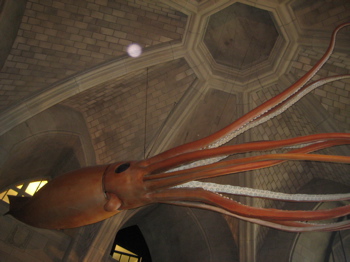
Horner goes on to say that “It’s easy to be a splitter. A fourth grader can do that, even a first grader can do that.” I tend to agree, but that’s not to say this debate isn’t without merit.
In 1891, famed fossil hunter John Hatcher sent Yale professor and Peabody curator Othniel Charles Marsh two horned dinosaur skulls from Wyoming. Since both skulls had a frill punctured with two large holes, Marsh dubbed them Torosaurus, which can be translated as “pierced lizard.”
Marsh also named the Triceratops. The Triceratops looks like the Torosaurus except the edge of the Triceratops’ neck frills are sometimes bordered by bony triangular knobs. The Triceratops also has no frill holes.
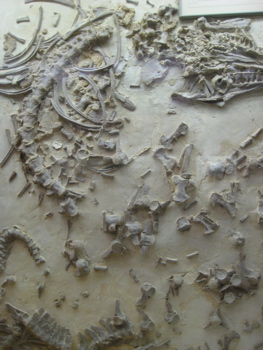
Over a century later, Anderson chose the Torosaurus after members of the Peabody Museum asked him to sculpt a Marsh-named dinosaur statue for the museum’s front lawn. The Torosaurus won Anderson over with its massive eight-foot long skull, rhinoceros-like body and general bizarre appearance, he said.
To build the statue, Anderson turned to paleontologist Andrew Farke, an expert on horned, frilled dinosaurs for guidance. Since no complete Torosaurus skeletons have been found, Farke said, the Triceratops, believed to be the Torosaurus’ closest cousin, was used as a model. Everything under the head of horned dinosaurs are nearly identical, Farke said so only the skulls really matter.
In 2005, the bronze statue arrived at the Peabody Museum, greeting visitors with its horn studded face, open beak and Triceratops body. “[The statue is] basically a Triceratops with a Torosaurus skull,” Anderson said.
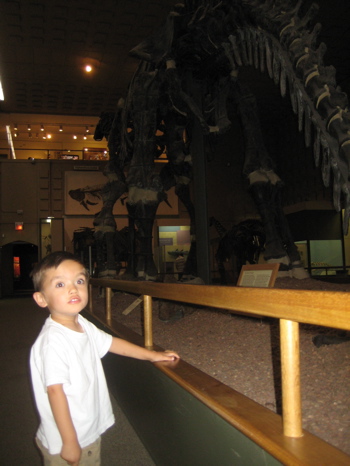
All that and we’re not even inside yet! I told you that I love this place. (Another cool thing out front that we missed is the Peabody Pothole.) As we step inside the absolutely beautiful building, we need to discuss how this museum came to be and its first curator and Bone War veteran, Othniel Marsh.
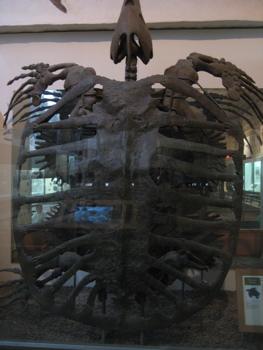
Actually, before Marsh there was George Peabody – a rags-to-riches American success story from South Danvers, MA (now named Peabody, MA) who paid for his nephew’s (Othniel Marsh’s) education at Yale. Years later, Peabody donated $150,000 to Yale to establish the Peabody Museum of Natural History there to be headed by Marsh. (Incidentally, he also gave $150,000 to Harvard for the Peabody Museum of Archaeology and Ethnology.
Marsh was one of the preeminent scientists in the field or paleontology; the discovery or description of dozens of news species and theories on the origins of birds are among his legacies. After graduating from Yale College in 1860 he traveled the world studying anatomy, mineralogy and geology. He obtained a teaching position at Yale upon his return. From the 1870s to 1890s he competed with rival paleontologist Edward Drinker Cope in a period of frenzied Western American prospecting now known as the Bone Wars.
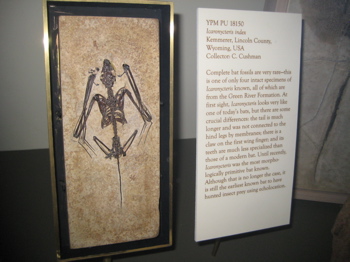
Ah yes, the Bone Wars. Marsh and his many fossil hunters were able to uncover about 500 new species of fossil animals, which were all named later by Marsh himself. In May 1871, Marsh uncovered the first pterosaur fossils found in America. He also found early horses, flying reptiles, the Cretaceous and Jurassic dinosaurs; Apatosaurus and Allosaurus, and described the toothed birds of the Cretaceous; Ichthyornis and Hesperornis.
Please, read more about the Bone Wars. The so-called “Bone Wars” featured the two men discovering and documenting more than 120 new species of dinosaur between them. Marsh eventually won the Bone Wars by finding 80 new species of dinosaur, while Cope only found 56. Marsh achieved this by buying Cope’s quarry sources out from under him, surprising Cope, who was originally his student. Cope did not take this lightly, and the two fought within scientific journals for many years to come, rumored to be at the expense of recognized scientific method.
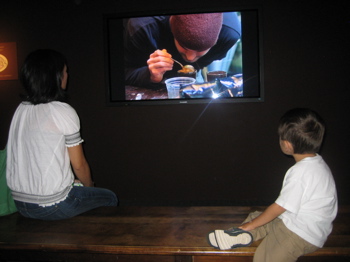
And that’s a shame, but sort of understandable I guess. Which brings us to today: Marsh’s finds formed the original core of the collection of Yale’s Peabody Museum. And check this out: The list of dinosaur genera he named – which doesn’t touch on the number of actual dinosaurs he named! He had two dinos named after him too – Othnielia and you guessed it, Marshosaurus.
The first Peabody Museum building opened to the public in 1876, but its capacity was soon strained by the huge dinosaur bones that Marsh’s collectors were sending in to the rapidly growing collections. In 1917 it was demolished to make way for a major dormitory complex, the Harkness Quadrangle. Construction of a new building was delayed by World War I, and the collections were in nearly inaccessible storage for seven years, until the current Peabody Museum building became ready for occupancy in 1924.
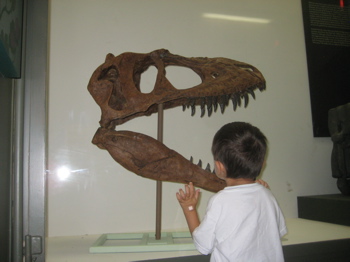
Dedicated in December 1925, the new building’s two-story Great Hall was specifically designed to accommodate some of O.C. Marsh’s dinosaurs, such as the mounting of the giant “Brontosaurus” (Apatosaurus), completed in 1931 after six years of labor. In 1947 Rudolph F. Zallinger finished the fresco secco painting that is probably the Yale Peabody Museum’s best known feature, the 110-foot mural The Age of Reptiles on the south wall of the Great Hall.
We’ll get to that mural later. I promise. The museum has been forced to shuffle and reshuffle its storage and collection facilities over the years, but that’s only a good thing, right?
I knew this was going to be a great museum upon stepping inside and seeing a giant squid suspended above my head. Everyone loves giant squids – and the Peabody’s is pretty darn cool.
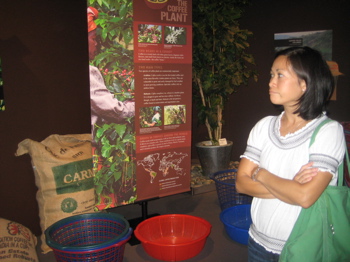
We went to the temporary exhibit area first and during our visit, it was all about Coffee. We like coffee, so it was mildly interesting to learn about the entire life-cycle of coffee trees and how the raw coffee nuts are turned into our daily cup of joe.

The exhibit did a good job of showing us the entire scope of the plant’s cultivation and its sometimes devastating effects on the local ecosystem. Also, it did a good job of making us feel guilty about all that, but I also learned that plants use caffeine as a natural pesticide to paralyze and kill destructive insects. On to the Great Hall!
The Great Hall is, in a word, awesome. As mentioned, this is where Marsh’s famous “brontosaurus” resides as a centerpiece, but really, that’s but one of a hundred interesting things in this one giant room. There are a whole bunch of other fossilized dinosaur skeletons. There’s an exceedingly rare complete Icaronycteris index (a primitive bat) fossil skeleton – one of only four thus far discovered.
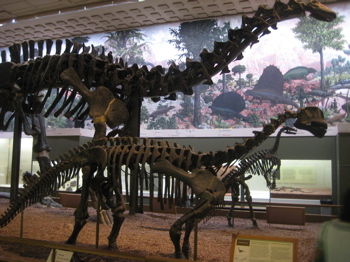
There is a whole explanation of the “brontosaurus” (aka Apatosaurus) vs. bronchiosaurus vs. Morosaurus (“moron lizard”… seriously) vs. Diplodocus skull debate. It’s all rather arcane and boring to anyone but paleontologists, but it really cuts to the heart of what science is about. Science admits and corrects mistakes and moves forward with knowledge as new discoveries are made. That’s why science is integral to the world. It is not dogmatic, despite the overuse of that world by wingnut zealots. And that’s why I love it.
I think our favorite skeleton here is the Archelon (ancient sea turtle). The specimen here is one of the largest and most complete specimens known. It measures ten feet, ten inches from paddle tip to paddle tip and probably weighed more than three tons. This particular guy is missing a back paddle, perhaps eaten by a shark. Delicious.
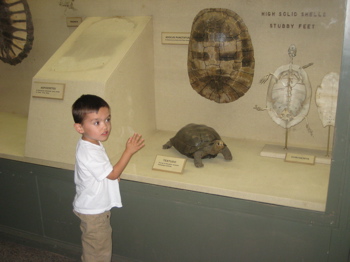
I can’t really explain what I love about the Peabody in a way to make you understand. It has an old school vibe that is both charming and educational. You are forced to READ stuff here, not push buttons or surf through an interactive kiosk. While I think those things have their place in museums and when they are done correctly, they can be very effective. But there’s just something about a huge respected museum just keeping it simple. With mid-century color-schemes and fonts – the golden age of such things to my mind – everything here is just so … so attractive.
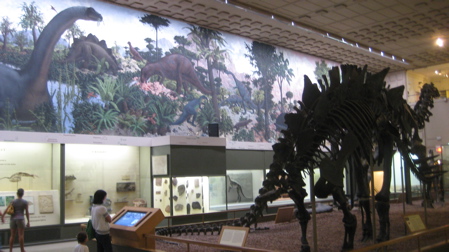
So when learning about fish evolution (something I studied extensively in college), it pleases the eye to do so. Now my special needs son almost NEEDS those bells and whistles to keep his attention. Yet, at the Peabody, Damian had fun looking at the skeletons and beautiful displays all afternoon. The effectiveness of combining the current species and their evolutionary ancenstral fossils keeps kids engaged and focused.
There’s a great display in the Great Hall about petrified wood too. As you see below, it’s the rare “petrified Wood” next to some petrified wood.
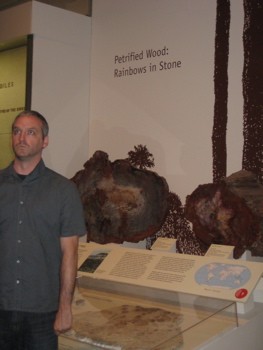
They even have some petrified Araucarian trees here with gem-like cross sections. These trees only live in tropical climates on today’s earth, but back in the dino-days they were quite common in what is now North America.
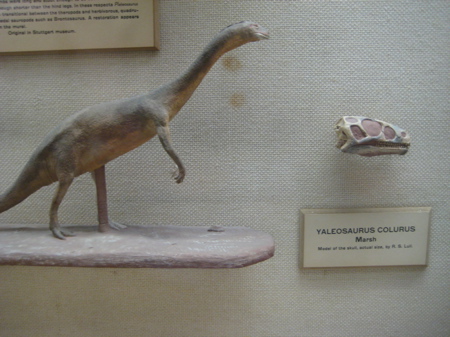
It’s amazing that Yalies named so many fossils and dinosaurs, so it only stands to reason that Yale has one named for it. Yes, ol’ Yaleosaurus colurus, a tiny little lizard that sort of looks like a miniature brachiosaurus. And yes kids, there is a nice T. Rex skull here as well.
Okay, so a bit about the beautiful huge mural that lines the upper wall of Great Hall. I urge you to Check out the Peabody’s page on the mural and watch the six minute video.

Rudolph F. Zallinger’s The Age of Reptiles mural occupies the full length of the east wall. The mural is one of the largest in the world, measuring 110 feet (33.5 meters) by 16 feet (4.9 meters). It required more than 4.5 years (1943–1947) to complete.
Painted in the Renaissance fresco secco technique, the mural is a work of art that showcases a panorama of the evolutionary history of the earth — from the Devonian Period 362 million years ago to Cretaceous Period 65 million years ago — based on the best scientific knowledge available at the time. The chronology of the mural reads from right to left and spans more than 300 million years, with the large foreground trees marking the boundaries between the geologic periods.
Zallinger’s portrayal of the prehistoric plants and animals was innovative for its time, showing them in natural, realistic landscapes, the result of the collaboration of the artist with the most preeminent paleontologists, paleobotanists, biologists and geologists of that day. In 1949 Zallinger received the Pulitzer Award for Painting in recognition of his work on The Age of Reptiles.
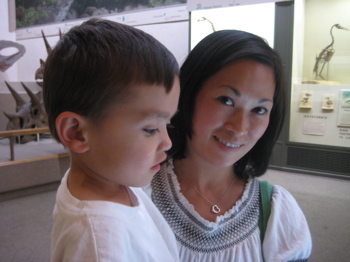
Unbeknownst to me at the time, photographing this behemoth is against the rules. (Not that a schlub like me could actually take a good picture of it anyway). It’s beautiful and historic and one of a kind.
On to the Hall of Mammalian Evolution! I’m going to cheat a bit here and just post what the Peabody has to say about this room:
“The fossils in this hall, from the Yale Peabody Museum’s collections in the Division of Vertebrate Paleontology, belong to the main groups of mammals that evolved during the Cenozoic Era (65 million years ago to the present), after the extinction of the dinosaurs. During this time mammals diversified into a wide variety of carnivorous, herbivorous and omnivorous forms. Overlooking the hall is the 60-foot mural The Age of Mammals, painted by Rudolph F. Zallinger in 1964, which dramatically illustrates the evolution of North American mammals during the Cenozoic Era.
Some of the largest fossils on display in Hall of Mammalian Evolution include the Otisville Mastodon (Mammut americanus) and the huge Brontotherium, both acquired in the 19th century by Yale’s O.C. Marsh.
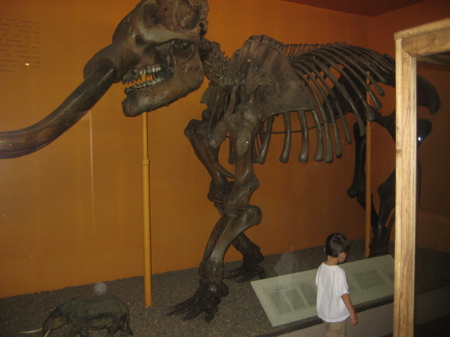
I love how Damian can just walk by a giant Mastodon like it ain’t nothin’. Anyway, the room contains a wealth of evolutionary biology like what defines us mammals – including inner-ear bones that are what paleontologists must use to ID fossils since hair and mammary glands are hardly preserved.
OMG! A giant ground sloth!
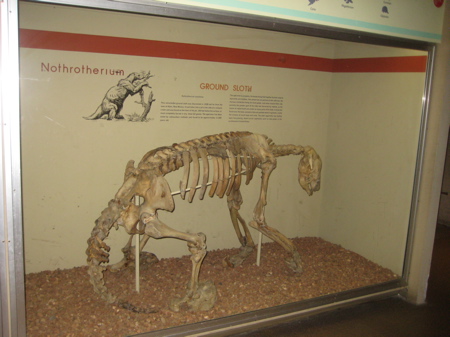
OMG! A giant ancient moose rack!
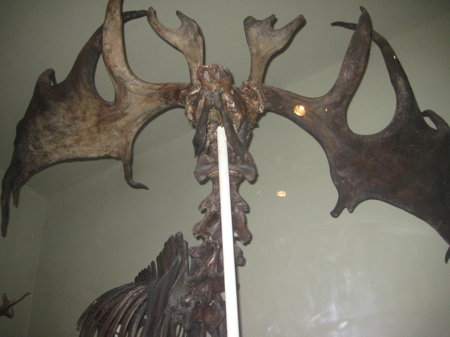
OMG! The evolution of horse teeth!
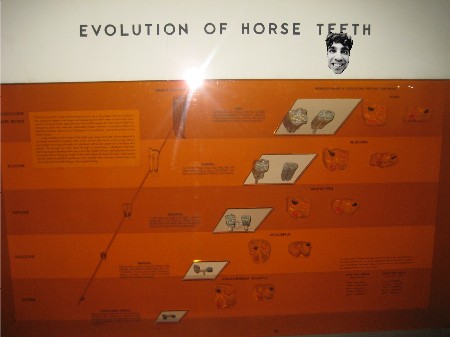
The museum has a wonderful display about primate evolution and, as one should hope and expect from any natural history museum, makes no mention of creationists. Not even to make fun of them. Please don’t read this website if you are one of those people.
The museum presents a whole room full of those vexing “missing links” and evidence the liars claim is missing, including a 1.6 million year old Homo erectus skeleton. There are also a whole host of skulls from varying Homo species and a concise narrative of how we Homo sapiens came to be. No mention of Adam or Eve.
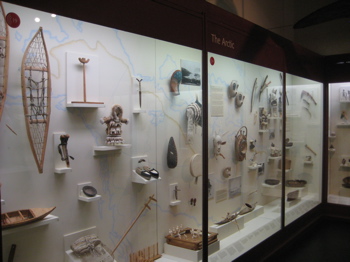
From the mammalian evolution stuff we moved through an interesting history of Polynesia, Native Americans and some Machu Picchu exhibit. I don’t mean to gloss over these things, as they are full rooms full of a ton of artifacts and interesting exhibits.
But you know, we’ve got to move along. Here are some pictures of these rooms:
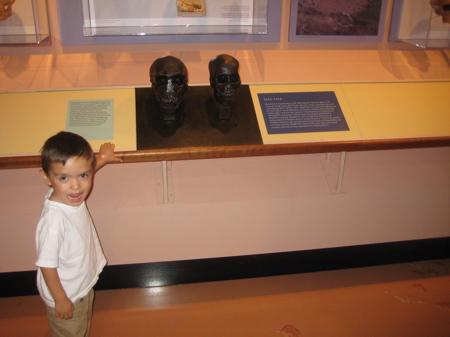
Skull Face!
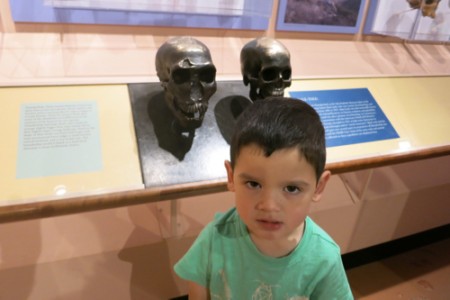
Calvin’s version, years later.
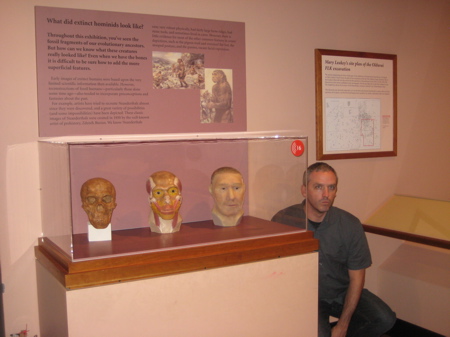
The evolution of man
And here’s some of what the Peabody has to say about this stuff:
The Hall of Native American Cultures showcases 360 objects from the Peabody’s substantial Native American collections in the Division of Anthropology. Showcased are a range of materials, from the tools of daily life—including Blackfoot, Apache and Sioux clothing, Cheyenne games, a Crow saddle, Navaho blankets, Zuni and Hopi pottery, and Pima basketry—to impressive historical pieces, such as the headdress and pipe of Oglala chief Red Cloud presented to O.C. Marsh in gratitude for his role in exposing corruption at the Bureau of Indian Affairs.
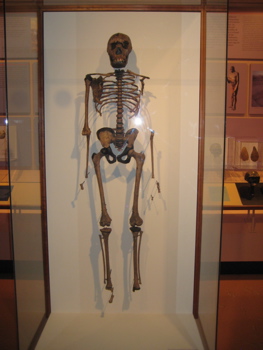
Let’s go upstairs. Heck, even the stairs here are cool.
Here we stumbled into the Discovery Room, which is probably meant to be the favored place of little kids. But with live leaf-cutter ants doing their thing, I was mesmerized myself. More, from the experts:
The Discovery Room is one of the most popular destinations at the Yale Peabody Museum, visited by more than 60,000 people a year. Full of touchable specimens and hands-on activities, the Discovery Room also houses interesting live animals from both around the world and right in your own backyard — endangered poison dart frogs from South America, giant hissing cockroaches from Madagascar, tropical leaf-cutter ants from Trinidad, a bearded dragon from Australia, and harmless eastern milk and rat snakes from New England.
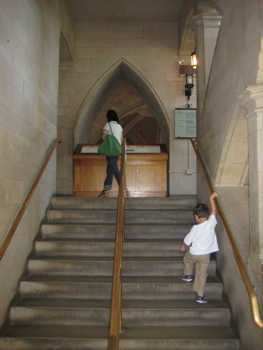
The Discovery Room’s most important rule is “Please Touch!”
Early on in my adult life I became enamored with E.O. Wilson (Shh! He’s a Harvard guy!) who is the world’s foremost expert on ants. (The NOVA about him is great.) Ants are amazing creatures and the leaf-cutters are just nuts. Anyway, there are all sorts of random things up in the Discovery room area and nearby. Like a replica Rosetta Stone. And an anaconda skeleton. And a giant piece of fossil poop:
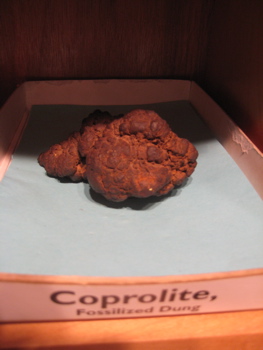
There’s some neat stuff about insects and then a bunch of exhibits on meteorites. The museum has the Red River meteorite which, for a long time, was the largest one yet discovered in the world. If you haven’t picked up on it by this point, I really enjoy these random artifacts scattered about the place. There’s a new crazy thing around every corner! Such as… Do you know what a fulgurite is? Here is a terrible picture of one:
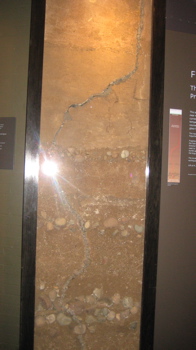
A fulgurite is the result of a lightning strike into sandy soil. With the lightning raising the temperature to over 2,900 degrees, it melts the sand along its course. The molten material cemenets adjacent sand grains in a glass-lined tube which called, you guessed it, a fulgurite. The Peabody has a nice one that was found up near Lake Congamond “in northern Connecticut.” Well, it may have been found in Connecticut, but Lake Congomond is in Massachusetts. TAKE BACK THE NOTCH!
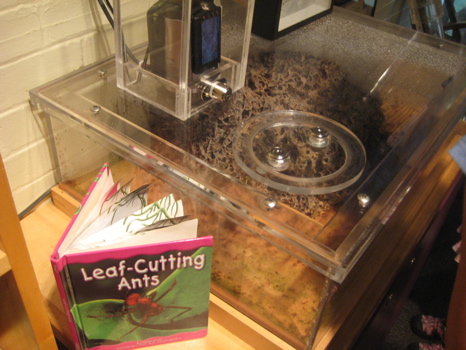
But it was time to head up to the third floor and the absolutely stunning dioramas.
Earlier, I wrote that I enjoyed the sort of mid-century vibe as it relates to the fonts and color schemes at the Peabody. The turquoise blues and (perhaps) Rockwell fonted signage just really work for me. I absolutely loved these rooms. The lighting, the skilled taxidermy, the enjoyment Damian found at each new window… It was just a great moment for me.
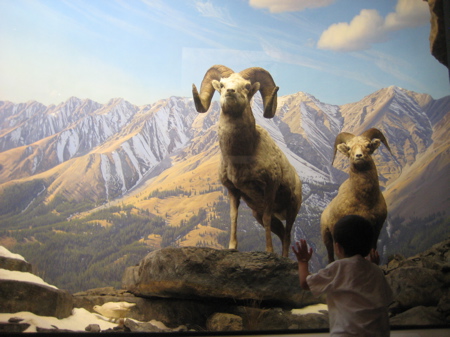
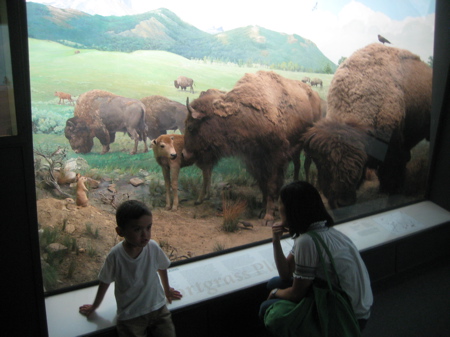
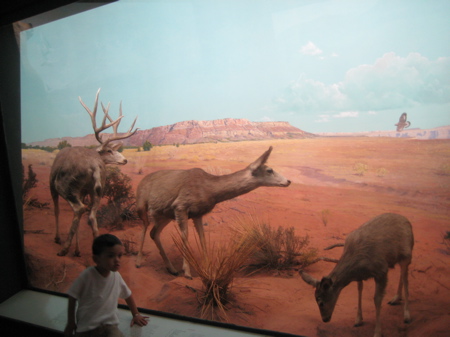
Of course, it also helps to have some of the best dioramas in the world here at the Peabody. As I viewed them I remember remarking to Hoang that these were the best I’ve seen save, perhaps, those at New York City’s Natural History Museum. The many displays are broken up into North American dioramas and southern New England dioramas. In between, there is a very comprehensive and impressive display of Connecticut birds. In other words: we spent a lot of time here.
Some more on the incredibly done dioramas:
In the museum world, the Yale Peabody Museum’s dioramas are considered masterpieces. In them our eye moves effortlessly from the specimens in the foreground to the background through the veil of atmosphere, into a vista that seems to stretch endlessly beyond the horizon. We accept the diorama as casually as if it were a window into the natural world.
A diorama combines three-dimensional foreground material with a curved background wall and domed ceiling to tell the story of an ecosystem. Our attention is focused on the flora and fauna in the foreground; the painted background and ceiling establish time, place and mood.
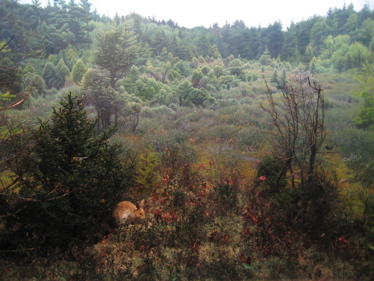
J. Perry Wilson (1889–1976) was one of three men responsible for the exquisite Peabody Museum dioramas. Both he and Francis Lee Jaques (1887–1969) had honed their skills painting diorama backgrounds at the American Museum of Natural History before receiving commissions to do similar work at the Peabody. Ralph C. Morrill, for 43 years the Peabody’s Chief Preparator, collaborated with both artists; it was he who created the dioramas’ extraordinarily lively — and lifelike — foregrounds.
For several years, beginning in October 1944, Perry Wilson was periodically on leave from the American Museum to work with Ralph Morrill on the Hall of Southern New England dioramas, the largest being the 35 foot-long Coastal Region (detail at left). Several groups in the North American Hall (such as the Kaibab Plateau diorama, below) were the work of Francis Lee Jaques.
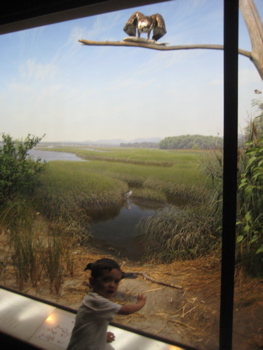
Both artists brought an extraordinary sense of mood and atmosphere to diorama painting, but Wilson added something else: his own unique system for transferring the background image onto a background surface of any shape. This technique was an important advance because it could be adapted to any of the oddly-shaped spaces diorama artists often have to work with. The Wilson method enabled him to avoid the inaccuracies inherent in freehand drawing. Regrettably, few artists working now are even aware of the technique.
Wilson’s skillful treatment of water, rocks, marsh grass, forest floor, or sphagnum moss in the background also facilitated the installation of plants and animals in the foreground. Generations of visitors have spent countless hours trying in vain to determine where foreground becomes background in a Wilson–Morrill diorama. The illusion is enhanced by the use of a two-inch separation between these parts of the scene; when properly lit, shadows cast by the foreground material fall unseen, not on the background.
You can tell how great these are even from my terrible pictures. That’s saying something.
The bird displays are bit more utilitarian, more just focusing on the birds themselves and not any art surrounding them. But that’s okay, because birds are beautiful on their own, right?
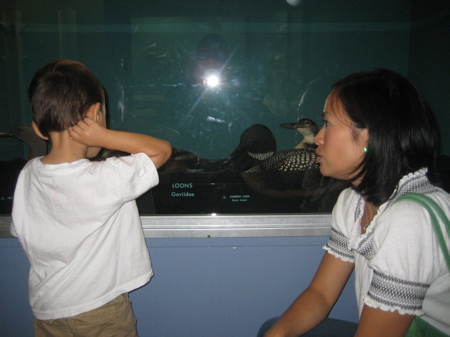
“Damian, how many loons are here?”
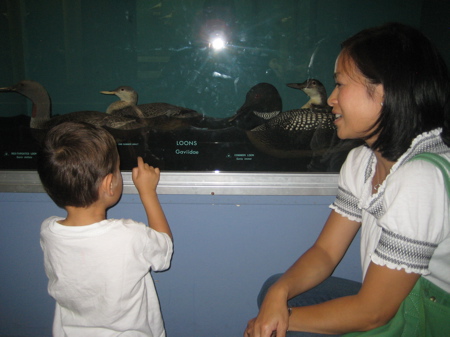
“1, 2, 3, 4…”
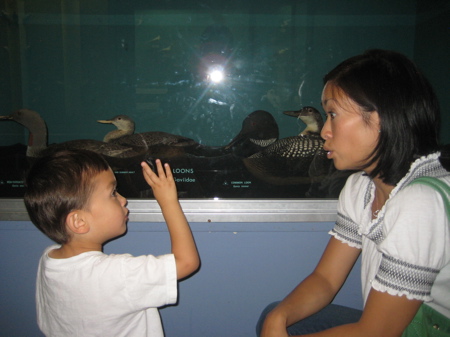
“Four!” Uh, sorry kid, you forgot the two in the white shirts.
A snippet from the museum’s site –
The 722 mounted specimens in the Birds of Connecticut Hall are the more than 300 species that occur regularly in the state, with each species represented by one or more specimens showing sex, age and seasonal plumage differences. The birds are mounted in poses typical for their group. Speciation, hybridization, plumage change and odd plumages are explained in 4 special displays. The preparation and design of this exhibition, which required five years to complete, was directed by Shirley Hartman; it opened to the public on May 12, 1972.
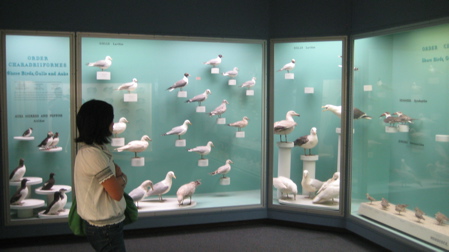
And they were sure to not forget the goatsuckers! Who doesn’t love a good goatsucker?
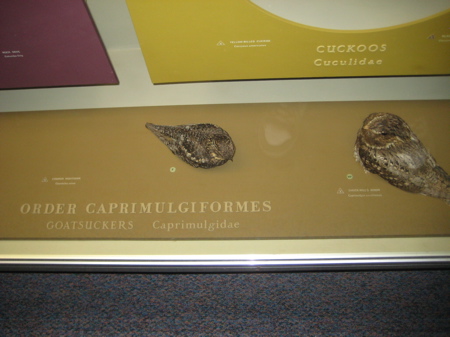
Whereas I could spend forever in the wildlife rooms, Hoang is more inclined to do say with the Peabody’s Egyptian stuff. While I certainly find it interesting, it just has never captivated me. Even though there is an actual mummy here. And some other incredibly impressive stuff. There’s a lot to take in here, from a 1st century AD reed pen to a piece of papyrus with hieroglyphics on it. While those artifacts got my attention the most, the Peabody rightly highlights some of the other stuff.
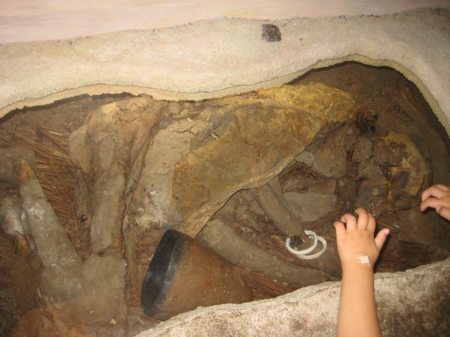
Mummy!
The Yale Peabody Museum and its sister museum, the Yale University Art Gallery (CTMQ Visit here, have between them collections that span Egyptian civilization from the Predynastic Period (c.4500–3100 BC) through the Greek and Roman Periods (332 BC–AD 640), a long sweep of time encompassing both remarkable change and remarkable continuity.
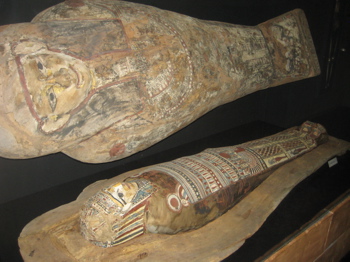
“Daily Life in Ancient Egypt” announces itself with an impressive and dramatic entrance façade, constructed by the Museum’s resourceful Construction Shop. Passing into the heart of the exhibition, you enter a setting that suggests the richness and complexity of a great and wondrous civilization, and bringing out the true beauty and power of the Egyptian collection. This exhibition attempts to embody current Yale research in Egyptian civilization, for which the Peabody collection has been an important resource.
The objects on display include the granite Head of Osiris, the relief of Mentu-her-khepeshef Worshiping Osiris, and the black diorite Bust of a Ptolemaic King, widely regarded as the finest piece of Egyptian sculpture at Yale, offer great insight into Egyptian society. So, too, does the votive piece Kneeling Statue of an Official.
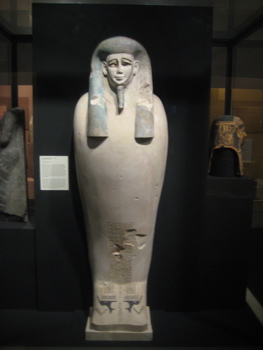
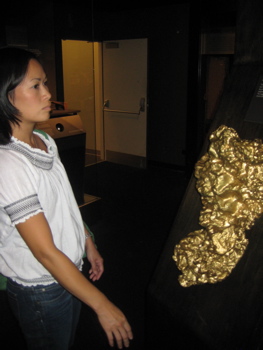
The last large “hall” is devoted to Gems, Rocks and Minerals. As you’d expect, the exhibit is perfectly put-together and very well presented with some amazing nuggets here. Get it? Nuggets? Actually, the giant gold nugget on display is but a replica of the largest gold nugget ever found (in Australia) because that one at more than 150 pounds, was immediately broken up and sold in London in 1869.
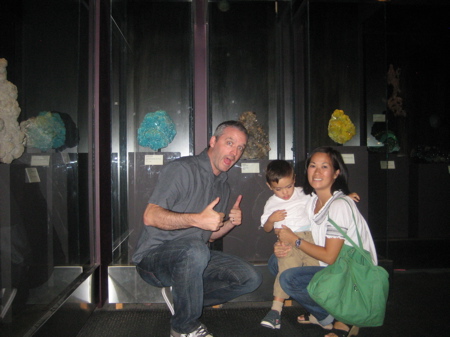
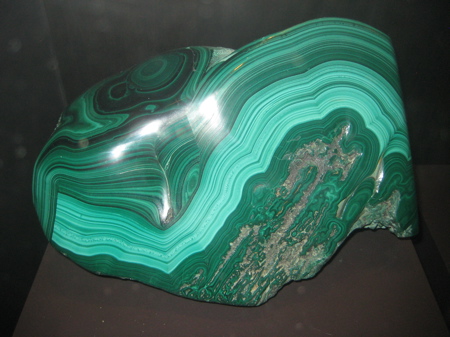
Here we found a ton of beautiful gems and minerals from around the world – the majority of which we’d never heard of before. I’m tired of cutting and pasting, so here, read all about this stuff on your own. I dig it (Oh, I’m good), but realize this page is too long.
As I’ve said twenty times already, the Peabody is awesome. I’m sure it’s the rare re-re-visit museum for us. This is the rare place that appeals to everyone from 3 to 103 – and it’s not too expensive either. The Peabody is a top 10 treasure in the state.
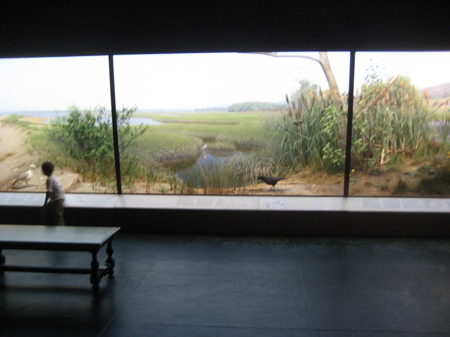
![]()
The Yale Peabody Museum of Natural History
CTMQ’s Museum Visits

 Peter says
Peter says
February 24, 2012 at 10:41 amSchool field trip memories …
 martinet says
martinet says
February 24, 2012 at 12:20 pmWe love, love, love the Peabody! I’d been looking forward to your review. You did not disappoint.
My mother, who works for the Missouri Historical Society, taught me that the type of natural history museum of which the Peabody is a sterling specimen, is referred to as a “dead zoo” in the museum biz. I love this term. And, as far as science museums go, I’ve always liked the “dead zoo” format far more than the interactive, physics-based type of science museum. St. Louis had a wonderful example of the former when I was a child (part of the reason I love the Peabody, in fact–it’s very similar) but that closed when their big Science Center opened, and I’ve always been kinda bitter about that fact. I feel pretty much the same way about the CT Science Center–it IS nice for what it is, but give me the old-time dead zoo vibe of the Peabody any day.
 cullen harper says
cullen harper says
July 27, 2017 at 6:24 pmin 1964 my father walked me {at age 14 }into the president’ s office {proper title ?} of the peabody museum and inquired if there might be a job open for his son…. something for him to do for the summer…a phone call was made and ralph morrill appeared and after some discussion about my interests and “qualifications” – eagle scout w/ 37 merit badges from a small troop in linglestown pa.- mr. morrill offered me a position as his assistant – and as this position was currently not in the budget i could volunteer if i were interested. I spent 2 summers working on study skins and other prep work for mr morrill – was promoted to a .50 per hour – and was able to contribute when i returned from a linglestown boy troop snake roundup with a pregnant rattle snake which gave birth to young while being filmed by mr morrill’s staff. what a great experience for a kid growing up. thank you very much mr morrill.